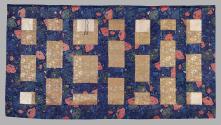Advanced Search
Buddhist priest's robe (kesa)
Japanese
Edo Period
19th century
Object Place: Japan
Medium/Technique
Silk, gilt paper
Columns: 4/1 satin foundation patterned with weft floats bound in 1/2 twill order and continuous supplementary wefts (gilt paper) bound in 1/4 twill order
Dividing bands: 4/1 satin weave patterned by continuous (gilt paper) and discontinuous (silk) supplementary wefts bound in 1/2 twill order
Pieced and appliquéd (shuchin)
Columns: 4/1 satin foundation patterned with weft floats bound in 1/2 twill order and continuous supplementary wefts (gilt paper) bound in 1/4 twill order
Dividing bands: 4/1 satin weave patterned by continuous (gilt paper) and discontinuous (silk) supplementary wefts bound in 1/2 twill order
Pieced and appliquéd (shuchin)
Dimensions
Height x width: 109 x 205 cm (42 15/16 x 80 11/16 in.)
Credit Line
William Sturgis Bigelow Collection
Accession Number11.3943
NOT ON VIEW
CollectionsAsia, Fashion and Textiles
ClassificationsCostumes
DescriptionSeven-columned kesa with decoration of peonies. Columns: brown silk figured satin-weave ground with peony branches and flowering plant motifs. The peony branches alternate with Western-style bending boughs in a repeat pattern. Dividing bands, border: dark blue silk figured satin-weave ground with designs of peony branches. Shiten, niten: white silk ground with woven-in patterns of double-tendrilled scrolling vines with peonies in supplementary wefts of flat gold-leafed paper thread. Lining: degummed red wefts.
ProvenanceBy 1911, purchased by William Sturgis Bigelow (b. 1850 - d. 1926), Boston [see note 1]; 1911, gift of Bigelow to the MFA. (Accession Date: August 3, 1911)
NOTES:
[1] Much of Bigelow's collection of Asian art was formed during his residence in Japan between 1882 and 1889, although he also made acquisitions in Europe and the United States. Bigelow deposited many of these objects at the MFA in 1890 before donating them to the Museum's collection at later dates.
NOTES:
[1] Much of Bigelow's collection of Asian art was formed during his residence in Japan between 1882 and 1889, although he also made acquisitions in Europe and the United States. Bigelow deposited many of these objects at the MFA in 1890 before donating them to the Museum's collection at later dates.



